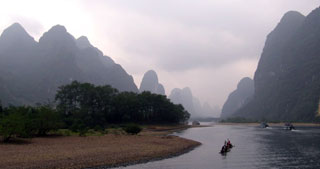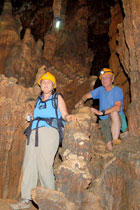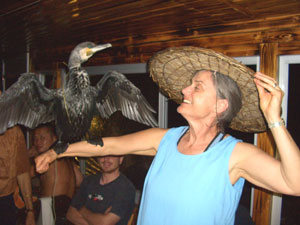China Karst October 2006 trip report
by Elaine Taylor
Published in the IOCAlum (Intercollegiate Outing Club Alumni) NEWS, January 2007

It was 25 years ago when I watched a young friend's slides of his bicycle trip to China, and learned about the "unreal" terrain around the Li River in southern China. Those fantastical mountain shapes depicted on fans and scrolls were not the products of Chinese imagination, but actually existed! That was why, when I first read about Dwight Deal's October 2006 trip to Guilin and Yangshuo in "IOCALUM News," and having been long familiar with his name from my OC days, I was interested. The idea of spending more than the usual tour's token few days in the area (for me), combined with the emphasis on "karst" and its attendant caves (for John) made it seem like this unlooked-for trip was a "carpe diem" opportunity.
I did have some ambivalence, not knowing how I would fit into a group of geologists and hydrologists, along with their respective partners, who had varying degrees of interest in things underground. I am pleased to report that I did find my role within the gathering, and that we all meshed, which helped to create a memorable vacation from which it was hard to return.
Due to the vagaries of airline schedules, the trip started with almost 2 full days (1 night) in Hong Kong. This was my first trip to Asia, and what a culture shock to this Colorado gal were the towers of Hong Kong, viewed across Victoria Harbour! An evening flight took us to Guilin, where we spent 4 nights. There we visited 3 caves, plus the entrance to the back country "insurgence" of one of them-- the only truly "wild" cave experience of our trip-- unlighted, although previously explored. It turns out that there are caves in those hills, part of the geological process of converting a karst plateau into the present landscape of discreet towers.

To those who might be reluctant to take part in a "cave" trip, I can assure you that most of the caves we visited were paved, with theatrical lighting that dramatically colored the "speleothems." Our group toured the caves with the understanding of the management that we were specialists, who wanted to linger in each area. The result was that we were frequently passed by subsequent groups of Chinese tourists. One could also take an above ground, optional tour under Mary's wing, if even 2 caves were 1 too many! Due to the excellent planning on the part of Dwight and Mary, I was pleased that I saw as many karst towers as I wanted-- whether on the 2 days of boat trips on the Li River, or in transit to caves in the countryside-- our little bus would stop whenever any of the 17 or 18 of us requested. (Our 18th participant was Australian Arthur Clarke, a specialist in the fauna of the caves of China, who departed mid-trip, to join a British caving expedition in central China.)
A morning, tourist-boat parade on the Li River transferred us to Yangshuo for 5 nights, where we had the opportunity to visit 5 more caves, 2 of which were only minimally developed, with occasional electric lights and primitive paths.
We had arrived in Yangshuo in the early afternoon. Most people wanted to settle into our hotel, or rest, with the result that only 6 of us actually went into the Buddha Water Cave, near Moon Hill, that Arthur was anxious to show us. I'm so glad we did-- it was my favorite cave! Yes, it had fixed incandescent light bulbs, but this one involved scrambling and using a few ladders, 1 or 2 knotted ropes, and 1 fixed chain! Not a wild cave, but a more active experience. If I have any disappointment about our trip, it was that more of the caves weren't like this one.
Other highlights of the trip included a visit to the Karst Institute in Guilin, where we were welcomed as honored guests. One evening in Guilin we watched the indoor show "Dream Like Lijiang" which included Chinese acrobatics. In Yangshuo, we saw the evening, outdoor production of "Impressions, Sanjie Liu" which used the Li River as its stage, while spotlights, illuminating the natural, karst towers, provided the scenery. Another night some of us went out on a boat to watch cormorant fishing. At the end (with the payment of an extra yuan or 2)-- what a thrill to hold a cormorant on my arm!
Our final night, as a group, was spent in a Zhuang minority village where the hillsides have been sculpted with garden terraces (mostly rice, but also taro, tea, and chilies, that we could recognize). En route, we had visited the Guilin Mineral Market, lunched at a tea farm, and braved the onslaught of Red Yao women in their stream-side village-- where upon payment, 5 or 6 of them took down their long, long hair, and demonstrated how they coil it around their heads.
Food-- awesome! So many dinners with seemingly endless courses! Always, chopsticks. Always-- tea, soft drinks and beer.
Toilets-- fortunately, in our hotels, always seated, "western style." Elsewhere-- take your chances, and always have hotel TP or a leftover napkin in your pocket. A hint-- handicapped toilet signs usually indicate a seat.
Water-- never potable from the faucet. Most hotels supplied token bottles of water; Dwight and Mary supplied some; others were purchased. John had brought his water bottle that has a built-in water filter, which was very nice to have, augmenting what the hotel supplied. We did not get sick, although I always travel with acidophilus capsules and I did take one on 2 different days, for insurance.
Electric Kettles in our hotel rooms-- one could do several boilings of the tap water to make it suitable for using. Not every hotel supplied tea in the room-- so bring your favorite teabags from home-- or risk buying unknown tea in a Chinese-labeled container.

Five of us said goodbye to the group at the Guilin airport, which was embarking for a final night in Hong Kong before flying home. The following day we 5 continued on to Beijing, where John and I had added 2 nights. We saw the Summer Palace on the afternoon of our arrival, under the tutelage of a guide, with whom we all "bonded," so that in the evening we invited her to have dinner with us. She led us to the restaurant that had originated Peking Duck. Ours came with a certificate-- the ducks being numbered continuously since the 19th century! On the pedestrian mall, our favorite shop was the Foreign Languages Bookstore, where we could buy Chinese books that had been translated into English.
The next day we went on a Great Wall tour with our small group. The kinetic experience of coping with the steepness of its hills and the irregular, sometimes too-high steps made The Wall seem even more awesome to me. Our tour included stops at a jade showroom, the Ming Tombs, and a silk showroom. We bade our 3 companions goodbye after a light supper. They were spending another night, and would visit the Forbidden City the next day. We were to depart the next morning at 5 AM, commencing our long day back to the US: Beijing-Hong Kong-LA-Denver.
This trip was the highlight of my travels in 2006. I look forward to joining Dwight and Mary on their proposed trip to the karst country of Slovenia-- in 2008(?). Meantime, I understand that they will repeat the China Karst trip next fall (2007). If what I have described tweaks your interest-- I recommend that you, too, seize the opportunity! Carpe diem!
Back to top
Back to SW China Karst Tour Information
View SW China Karst Itinerary
View Past SW China Karst Tour Photos
Reserve Your Spot on SW China Karst Tour









